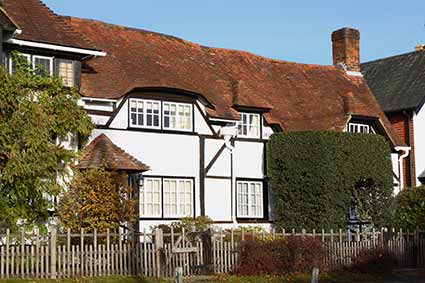Bank and Gritnam – historic houses

Located about 1.5 kilometres (1 mile) south-west of Lyndhurst village centre, Bank is a small hamlet close to the A35 Christchurch road.
The history of its houses and families has been researched by a number of local historians, prominent amongst them Mary Britten, who lived at Bank in an apartment at Annesley; and Roy Jackman, who came to Bank in 1922 when his father started work as the chauffeur at Annesley. And what a wealth of fascinating information has been revealed.
Amongst the oldest of the buildings is the appropriately named Old Cottage, on Pinkney Lane, which has displayed on an outside wall the date 1600. In 1838 it was occupied by widower Robert Cole, a gardener, who had one daughter, and a son who went on to become a gardener at nearby Cuffnells. The roof of Old Cottage was originally thatched, but in the 1920s it was tiled, and the cottage was extended.
A post office (or sub-post office) operated for a time in Bank, probably in the late 19th and early 20th centuries, and most likely from Old Cottage, outside of which still stands a post box dating back to the reign of George V (1910-36).
High on the list of contenders for the most picturesque building is The Thatch Cottage, a property set back from Pinkney Lane, overlooking the fields towards Lyndhurst. It is now difficult to imagine that just after the Second World War, it is understood to have been condemned as unfit for habitation. In 1841 it was owned by Lady Agnes Poore, of Cuffnells, and was a smaller building than today, yet it was occupied by an agricultural labourer, James Grant, his wife and eight children! They were followed by Thomas Taylor, his wife and seven children!
Many local 19th century residents worked on the land, although one, Harriet Kerr, was a governess in a boarding school located close to Deerhurst, opposite the Pinkney Lane entrance to Brick Kiln Inclosure. In 1881, however, only one scholar, a 13 year old girl, was resident. Bank’s other late-19th century school, this for local children, was situated on the lane leading to Gritnam.

Amelia Whitehorn in the middle years of the century owned three tenement cottages. One is now Ramblers Cottage, whilst the other two were combined and extended to become Acorn Cottage. Amelia was described in census records as a widow and shopkeeper, whilst another shop-keeping widow, Rachel Witcher, in 1838 lived in a cottage on the site of today’s Oak Inn.
Three laundresses were also recorded in the 1871 Census - the laundry early in the 20th century is thought to have been in the now beautifully thatched Japonica Cottage.
But perhaps Bank’s best known property is The Oak Inn, or the Royal Oak, as once it was known. An 18th century cider house on the plot dates back to the 1700s, whilst on the 1838 tithe map and schedules it was recorded as a cottage and garden, owned by Joseph Taplin and occupied by Rachel Witcher – the shopkeeper already mentioned.
The present building was constructed in the 1850s. The Lyndhurst Directory for 1851 shows Charles Taplin – a relative of Joseph? - and Henry Broomfield as ‘Beer Retailers’, whilst White’s Directory of 1859 shows the Royal Oak as occupied by Henry Broomfield, innkeeper. The inn stayed in the Broomfield family until at least 1938.
Find out more about Bank and Gritnam
References:
Lyndhurst Historical Society publications – The Story of Bank: Roy Jackman
Transcript of a talk given by Mary Britten to Lyndhurst Historical Society in 1984
Census records courtesy of the Christopher Tower New Forest Reference Library
More links
Other related links
Search this site

Sadly, 58 animals were killed - 35 ponies, 13 cows, 8 donkeys and 2 sheep, whilst a further 32 were injured - 3 pigs, 9 donkeys, 11 cows and 9 ponies.
(Forty-three accidents occurred in daylight, 15 at twilight and 101 in the dark. Twenty-seven accidents were not reported by the driver involved).
Here's just one horrific example - Three donkeys killed in collision with van at notorious New Forest blackspot (Advertiser and Times)

